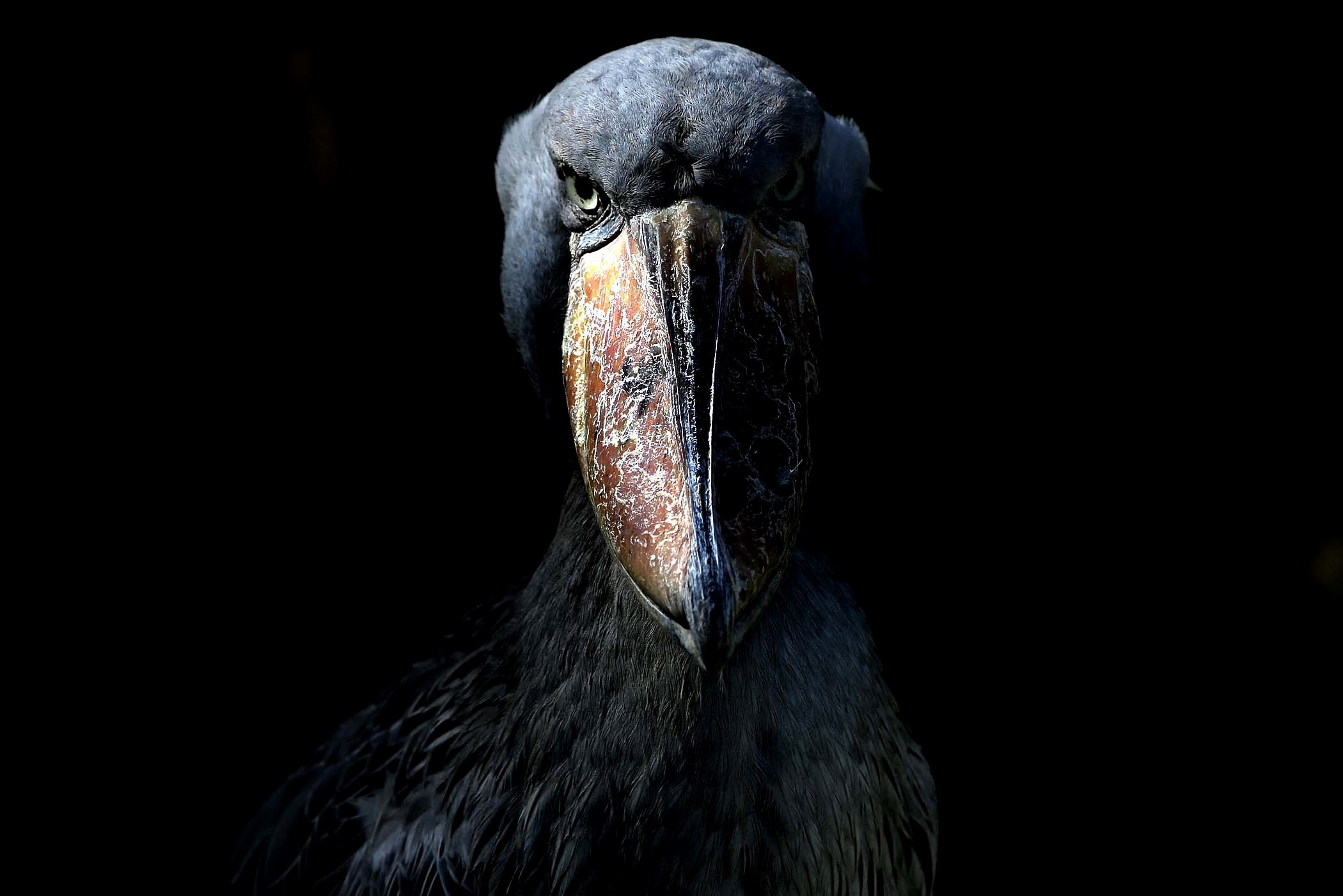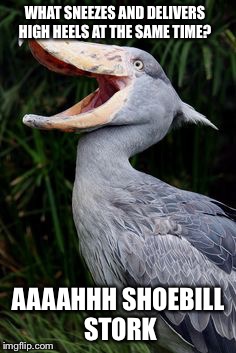

The dark coloured legs are fairly long, with a tarsus length of 21.7 to 25.5 cm (8.5 to 10.0 in). As in the pelicans, the upper mandible is strongly keeled, ending in a sharp nail. The exposed culmen (or the measurement along the top of the upper mandible) is 18.8 to 24 cm (7.4 to 9.4 in), the third longest bill among extant birds after pelicans and large storks, and can outrival the pelicans in bill circumference, especially if the bill is considered as the hard, bony keratin portion. The signature feature of the species is its huge, bulbous bill, which is straw-coloured with erratic greyish markings. A male will weigh on average around 5.6 kg (12 lb) and is larger than a typical female of 4.9 kg (11 lb). Weight has reportedly ranged from 4 to 7 kg (8.8 to 15.4 lb). Length from tail to beak can range from 100 to 140 cm (39 to 55 in) and wingspan is 230 to 260 cm (7 ft 7 in to 8 ft 6 in). The shoebill is a tall bird, with a typical height range of 110 to 140 cm (43 to 55 in) and some specimens reaching as much as 152 cm (60 in). The shoebill's conspicuous bill is its most well-known feature

All that is known of Eremopezus is that it was a very large, probably flightless bird with a flexible foot, allowing it to handle either vegetation or prey. It has been suggested that the enigmatic African fossil bird Eremopezus was a relative too, but the evidence for that is unconfirmed. So far, two fossilized relatives of the shoebill have been described: Goliathia from the early Oligocene of Egypt and Paludavis from the Early Miocene of the same country. A 2008 DNA study reinforces their membership of the Pelecaniformes.

In 2003, the shoebill was again suggested as closer to the pelicans (based on anatomical comparisons) or the herons (based on biochemical evidence). Microscopic analysis of eggshell structure by Konstantin Mikhailov in 1995 found that the eggshells of shoebills closely resembled those of other Pelecaniformes in having a covering of thick microglobular material over the crystalline shells. Based on osteological evidence, the suggestion of a pelecaniform affinity was made in 1957 by Patricia Cottam. Traditionally considered as allied with the storks ( Ciconiiformes), it was retained there in the Sibley-Ahlquist taxonomy which lumped a massive number of unrelated taxa into their "Ciconiiformes". The genus name comes from the Latin words balaena "whale", and caput "head", abbreviated to -ceps in compound words. John Gould described it in 1850, giving it the name Balaeniceps rex. The shoebill was known to ancient Egyptians but was not classified until the 19th century, after skins and eventually live specimens were brought to Europe. It used to be classified and put in Ciconiidae, however.Molecular studies have found the hamerkop to be the closest relative of the shoebill. Despite sometimes being known as a stork, it is not a true stork as they belong in the bird family of Balaenicipitidae, while storks belong to the bird family of Ciconiidae.Archaeopteryx and Cockatrice are the only other birds which this occurs with. Unlike most birds, Shoebill's Talons coloring option colors more than just the foot claws, coloring the beak hook.Shoebill is the first bird of 2022 with more than one flying animation.Build Nest - Under correct circumstances, spawns nest in current location.Display - Slowly lifts wing up while lifting head, then moves them down.Hurt - Falls to the ground with wings tilted out and head tucked in.Eat - Spreads wings out and slowly raises head, then jabs head down.

Grow - Allows chick to grow into an adult shoebill.Hurt - Falls onto the ground with head curled into the body and everything tucked in.Eat - Lifts up head before moving it down to bite ground.Has a unique sitting animation where its flattens its whole body onto the ground. Talons - Colors talons and hooked end of beak.Secondary Feathers - Colors some wing feathers.Primary Feathers - Colors majority of wing feathers.The tip of its beak is hooked and dark gray. Like the chick, its beak has a shoe-like shape. The eyes are yellow and the beak is orange. Its tail is short with dark blue plumage on the end. Its body mainly has light blue plumage, with the wing plumage being a darker blue. The adult is a tall bird with long legs and a large beak. The neck is long and the beak has a unique shoe-like shape. Its plumage is a very pale blue, with the legs being gray and the beak being a brownish color. The chick is a medium sized bird with a large beak.


 0 kommentar(er)
0 kommentar(er)
